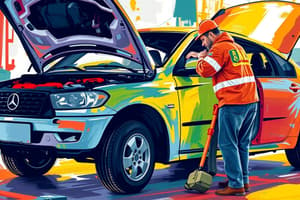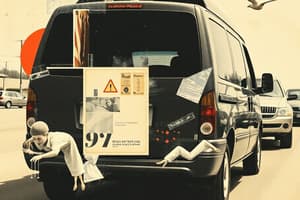Podcast
Questions and Answers
What should you check before entering the vehicle?
What should you check before entering the vehicle?
- The tire pressure
- The gas level
- The color of the car
- Behind the car for small objects (correct)
What is the recommended speed while backing up?
What is the recommended speed while backing up?
- Fast speed for quickness
- At a snail's pace (correct)
- Normal driving speed
- Moderate speed
How should your body be positioned while steering when backing up?
How should your body be positioned while steering when backing up?
Your body should be positioned to the right, with your arm over the passenger seat.
What should you do once you are in the vehicle?
What should you do once you are in the vehicle?
You should avoid backing up corners because it is very dangerous.
You should avoid backing up corners because it is very dangerous.
What steps should be taken when parallel parking?
What steps should be taken when parallel parking?
What should you do if you must take a sharp turn while backing up?
What should you do if you must take a sharp turn while backing up?
What is a tip for backing up safely?
What is a tip for backing up safely?
What can help you navigate when your movement is constricted?
What can help you navigate when your movement is constricted?
When making a three-point turn, signal with your right directional and pull over to the _____ and stop.
When making a three-point turn, signal with your right directional and pull over to the _____ and stop.
Before pulling out of a parking space, you should ensure that your wheels are _____.
Before pulling out of a parking space, you should ensure that your wheels are _____.
Flashcards are hidden until you start studying
Study Notes
Backing Up Safely
- Backing up a vehicle requires practice due to limited rear visibility; extreme caution is necessary.
- Maintain a safe distance of one car length for every ten miles per hour while driving.
- Prior to entering the vehicle, check the surrounding area for objects, children, and other potential hazards.
- Inside the vehicle, utilize mirrors while also turning your body to look directly behind.
- Position your body to the right with your arm over the passenger seat when preparing to back up.
- While backing, keep your head turned toward the right rear to monitor potential obstacles.
- Control speed by keeping the foot on the brake, releasing slightly for gradual movement; maintain tension for control.
- Travel slowly (at a "snail's pace") while backing up, ready to stop quickly; increase speed only when the path is clear.
- Consider installing backup sensors and alarms and adjust mirrors to reduce blind spots.
- Check seating and pedal adjustments for comfort and safety; lower windows to hear any hazards behind.
- When backing around corners, use the left hand for steering while checking mirrors and windows for clearance.
- Avoid backing out of corners when possible; vehicles may approach rapidly.
- For sharp turns while backing, use hand-over-hand steering techniques, positioning your body and head appropriately.
- After making a sharp turn, align the steering wheel with the roadway angle and proceed slowly.
- In constrained spaces, rely on mirrors and passengers for visibility to navigate safely.
- Whenever feasible, seek parking spaces that do not require backing out for easier exits.
- Steps for parallel parking: select a suitable space, check mirrors, signal intent, and position your vehicle correctly.
- During parallel parking, look over both shoulders while backing; turn the wheel towards the curb.
- Clear the vehicle ahead as you reverse; straighten wheels once aligned properly with the curb, and maintain an 18-inch distance.
- To navigate out of a parking space, ensure wheels are straight and back up cautiously, turning away from the curb.
- Six steps for safely entering traffic: check for hazards with your head turned, use the rearview mirror, signal intentions, check side mirrors, and proceed with caution through the traffic lane.
- Performing a three-point turn involves signaling, stopping to check traffic before turning left, crossing the road, and carefully navigating back to the right edge before pulling away safely.
Studying That Suits You
Use AI to generate personalized quizzes and flashcards to suit your learning preferences.




